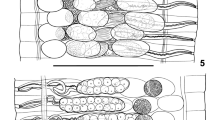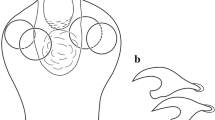Abstract
Calixolepis thuli n. g., n. sp. is described and figured on the basis of the specimens from the wood duck Aix sponsa (L.) (Anseriformes: Anatidae) from Cuba and the USA. The tapeworm is characterised by: (1) strobila of medium size; (2) deep genital atrium; (3) external accessory sac; (4) unilateral genital pores, with female genital ducts situated anterior to male ducts; and (5) the following characteristic structure of the male and female terminal genitalia: the genital pouch has a stylet and a goblet-like structure, the calix; a cirrus is absent; and the thick-walled copulatory part of the vagina forms vaginal vestibule distally which may open through a vaginal papilla into the genital atrium. Other morphological structures indicate a relationship with species of the genus Sobolevicanthus Spasskii & Spasskaya, 1954 or with Cladogynia Baer, 1938 (Hymenolepididae). The differences between the tapeworms from Cuba and the USA suggest the possible occurrence of various morphological forms of Calixolepis.
Similar content being viewed by others
References
Baer, J.G. (1938) Un genre de cestode d'oiseaux. Bulletin de la Société Neuchâteloise des Sciences Naturelles, Année 1937, 62, 149–156.
Czaplinski, B. & Vaucher, C. (1994) [Family Hymenolepididae Ariola, 1899.] In: Khalil, L.F., Jones, A. & Bray, R.A. (Eds) Keys to the cestode parasites of vertebrates. Wallingford: CAB International, pp. 595–663.
Drobney, R.D., Train, C.T. & Frederickson, L.H. (1983) Dynamics of the platyhelminth fauna ofwood ducks in relation to food habits and reproductive state. Journal of Parasitology, 69, 375–380.
Garrido, O.H. & Montaña, F.G. (1975) Catalogue of birds from Cuba. Havana: Cuban Academy of Sciences, 149 pp.
Jones, A. & Khalil, L.F. (1980) The helminth parasites of the lesser flamingo, Phoeniconaias minor (Geoffroy), from lake Nakuru, Kenya, including a new cestode, Phoenicolepis nakurensis n. g., n. sp. Systematic Parasitology, 2, 61–76.
Macko, J.K. (1990) On the variability and taxonomy of dicranotaeniids (Hymenolepididae, Cestoda) of Anseres in Eastern Slovakia. II. On the most important taxonomic characters of Dicranotaenia coronula (Dujardin, 1845). Helminthologia, 27, 55–65.
Macko, J. K. (1991) Description of Dicranotaenia stenosacculata Macko, 1988 (Cestoada, Hymenolepididae). Helminthologia, 28, 13–17.
Mas-Coma, S. & Galan-Puchades, M.T. (1991) A methodology for the morphoanatomic and systematic study of the species of the family Hymenolepididae Railliet et Henry, 1909 (Cestoda: Cyclophyllidea). Research and Reviews in Parasitology, 51, 139–173.
Schmidt, G.D. (1986) Handbook of tapeworm identification. Boca Raton, Florida: CRC Press, 675 pp.
Schmidt, G.D. & Dailey, M.D. (1992) Amazilolepis trinidadensis gen. n., sp. n. (Cestoidea: Hymenolepididae) from the copperrumped hummingbird, Amazilia tobaci, in Trinidad, West Indies. Journal of the Helminthological Society of Washington, 59, 117–119.
Spassky, A.A. (1963) [Hymenolepididae – tapeworms of free-living and domestic birds.] Essentials of Cestodology. Vol. 2. Moscow: Nauka, 417 pp. (In Russian).
Spassky, A. A. & Kornyushin, V. V. (1971) On the morphological evolution of gonads in hymenolepidid and dilepidid tapeworms. Doklady Akademii Nauk SSSR, 198, 1,232–1,234. (In Russian).
Thul, J.E., Forrester, D.J. & Abercrombie, C.L. (1985) Ecology of parasitic helminths of wood ducks, Aix sponsa, in the Atlantic Flyway. Proceedings of Helminthological Society of Washington, 52, 297–310.
Author information
Authors and Affiliations
Rights and permissions
About this article
Cite this article
Macko, J.K., Hanzelová, V. Calixolepis thuli n. g., n. sp. (Cestoda: Hymenolepididae) from the wood duck Aix sponsa (Anatidae) in America. Syst Parasitol 38, 137–145 (1997). https://doi.org/10.1023/A:1005881709810
Issue Date:
DOI: https://doi.org/10.1023/A:1005881709810




